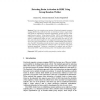6 search results - page 1 / 2 » Detecting Brain Activation in fMRI Using Group Random Walker |
MICCAI
2010
Springer
13 years 3 months ago
2010
Springer
Due to the complex noise structure of functional magnetic resonance imaging (fMRI) data, methods that rely on information within a single subject often results in unsatisfactory fu...
CVPR
2010
IEEE
13 years 10 months ago
2010
IEEE
Noise confounds present serious complications to accurate data analysis in functional magnetic resonance imaging (fMRI). Simply relying on contextual image information often resul...
ICASSP
2007
IEEE
13 years 10 months ago
2007
IEEE
— Within-subject analysis in event-related functional Magnetic Resonance Imaging (fMRI) first relies on (i) a detection step to localize which parts of the brain are activated b...
ISBI
2008
IEEE
14 years 5 months ago
2008
IEEE
Multi-subject analysis of functional Magnetic Resonance Imaging (fMRI) data relies on within-subject studies, which are usually conducted using a massively univariate approach. In...
MICCAI
2004
Springer
13 years 10 months ago
2004
Springer
Abstract. So far, resting state functional connectivity (RSFC) has been performed mainly by seed correlation analysis (SCA) on functional MRI (fMRI) studies. In previous studies, t...

